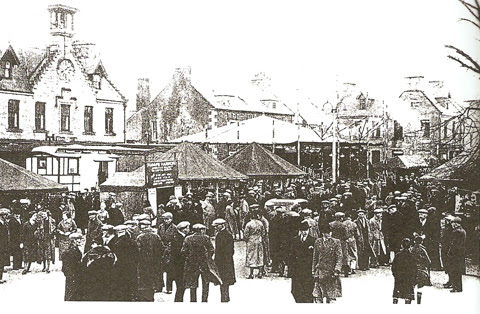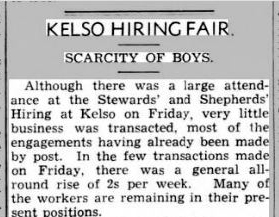This week’s Sepia Saturday prompt photograph shows a crowd of people gathering in a Market Square. A cue for me to feature my home village of Earlston in the Scottish Borders and the Crowds that gathered there in the early 20th century for the twice annually held Hiring Fairs.

Earlston Hirng Fair, 1909
EEarlston Hiring Fairs, held in the Market Square twice a year, were important events where men and women farm workers, (Ag. Labs. Shepherds, *Hinds, Dairy Maids etc.) would gather to bargain with prospective farmers for work, and hopefully secure a position for the following 6-12 months.
*The Scottish National Dictionary defines a "hind" in Southern Scotland and Northumberland as "a married skilled farm worker who occupies a cottage on the farm and is granted certain perquisites in addition to wages.

The distinctive work costume of the Bondagers
Bondagers were female farm workers in south east Scotland and Northumberland. As part of their husband's contract (or bond) with the farmer, he would undertake to provide another worker (usually his wife) to help as and when required. The women wore a distinctive dress with bonnet, described as the "last remaining peasant costume" in Britain. The custom of bondagers lasted well into the 20th century.
Hiring Fairs were also social occasions with a rare opportunity for friends and family to meet and enjoy side shows and stalls, with often a a chance to take teas in the Masonic Hall, or a dram in one of the public houses, or even all-day dancing in the Corn Exchange - some activities that earned the disapproving of the church.
"The Southern Reporter" of 1st March 1883 gave us this contemporary account of one such fair.

Earlston Hiring Fair, c.1930s
Special trains were laid on by L.N.E.R. (London & North East Railway) offering cheap days excursions to Earlston for the event.
Seeking Farm Vacancies But Times were changing, and increasingly during the 1930s farm vacancies were being advertised in the local press. Workers were also showing a reluctance to move, especially if they were already living near a town or on a bus route and their farm cottages were being improved.
A
typical listing of farming jobs advertised in "The Southern Reporter":
10th March 1936. Note that no pay is quoted, and many posts stipulated, along, with the man, a wife to look after cows and poultry
and strong boy(s) to assist on the farm.
A report on Kelso Hiring Fair in "The Southern Reporter" 10 January 1938 was typical of the concern for the future.
their family history and memories through photographs.

****************************



We have hiring fairs but call them Job Fairs and there are more than farm jobs represented of course, nor do husbands promise their wives to work or vice versa. :) They are always highly attended because folks are constantly looking for work, or things to become interested in as hobbies, perhaps.
ReplyDeleteThank you for your comment, Gail. These Hiring Fairs died out pre WW2. Here Job Fairs today are usually held at schoola, colleges and university to give careers advice, rather than match employer and employee.
DeleteMy son has run a fair where 70 different businesses in the same basic field (health care or hospitality for instance) set up booths, and several high schools then bussed students to the fairgrounds to see what is on offer.
ReplyDeleteOh - I am still impressed with the way farm labor used to be acquired, since I always assumed it stayed the same for a family's lifetime. Glad the fun part still remains!
DeleteWe used to have city-organized labor exchanges here. But today these fairs are organized by businesses in need of labor. I remember that contracts for agricultural labor were renewed yearly during the winter. But usually, people remained with their employer for years. They lived in the nearby village and not on their employer's property.
ReplyDeleteAlthough the fairs still exist, the social element, visible in your pictures, disappeared.
What a great history lesson! I didn’t know any of this about farm workers.
ReplyDeleteSusan
It's always fascinating to learn how rural communities organized farm work in the olden days. I did not know that farmers would seek out seasonal laborers who came with extra "hands" like a wife or sons. I wonder how far migrant farmer workers traveled to seek jobs. Did they return to their original homes or just keep on the move? The improvements in farm machinery must have forced many into the cities to find factory work.
ReplyDeleteThank you all for sharing your thoughts on my post Farm labourers (or known as Ag. Labs. here ) did move around quite a bit , as you can tell from Census Returns, recording children born in several different parishes.
ReplyDeleteAs usual, I forgot to identify myself in the previous comment.
ReplyDelete